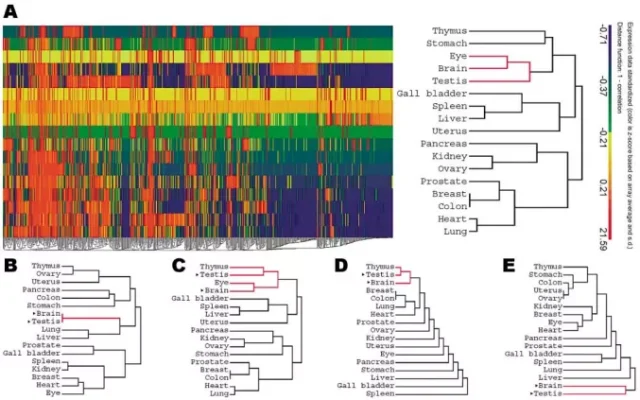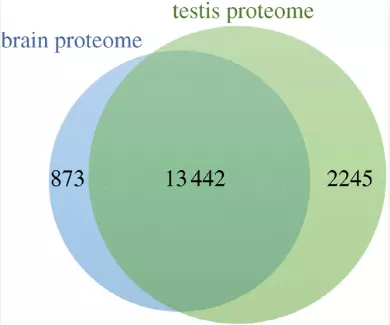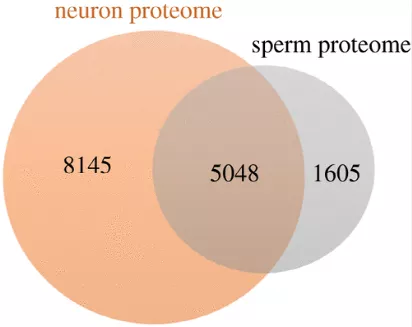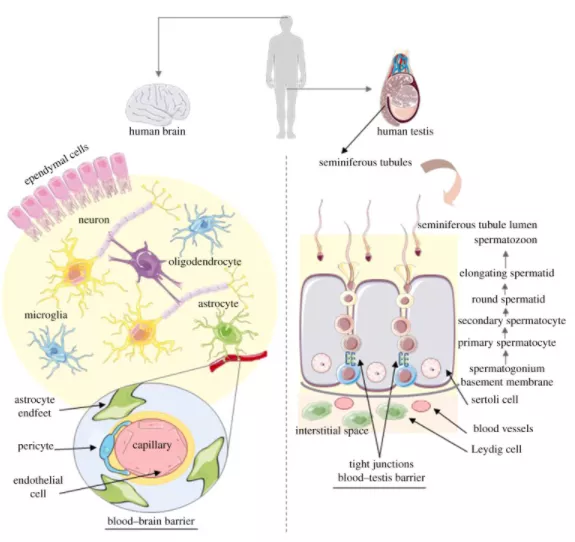Is the testicle the most brain-like organ?
- Normal Liver Cells Found to Promote Cancer Metastasis to the Liver
- Nearly 80% Complete Remission: Breakthrough in ADC Anti-Tumor Treatment
- Vaccination Against Common Diseases May Prevent Dementia!
- New Alzheimer’s Disease (AD) Diagnosis and Staging Criteria
- Breakthrough in Alzheimer’s Disease: New Nasal Spray Halts Cognitive Decline by Targeting Toxic Protein
- Can the Tap Water at the Paris Olympics be Drunk Directly?
Is the testicle the most brain-like organ?
Is the testicle the most brain-like organ? Genes are highly similar, sharing 13,442 kinds of proteins.
The human body is a large precision factory, ranging from system organs to small tissue cells.
All departments work together, and employees perform their duties to jointly maintain the stable operation of the entire factory.
As the leadership in the factory, the brain is the master control center of the nervous system and plays an important coordinating role.
The male gonadal testis is the human resources department of the factory, and its main function is to produce sperm and synthesize and secrete hormones (mainly testosterone).
Regardless of form, structure, and function, the brain and testis are very different.
But in recent days, more and more studies have overturned people’s common sense and found that not only the human brain and testicles are closely related, but there are many similarities.
As early as 2003, Chinese scholars found through computer analysis that among the 17 tissues of the human body, the gene expression patterns between human brain and testis had the highest similarity .
This means that perhaps the male testis plays an important role in the formation of human species.

The testis and the brain share many similar genes
After this interesting and surprising discovery, more scholars began to explore the connection between the brain and the testicles.
Scholars such as Rosalind Arden from King’s College London, UK have also found that intelligence and semen quality have a strong positive correlation .
The results showed that male intelligence was significantly positively correlated with log sperm concentration (r=0.15, p=0.002), log sperm count (r=0.19, p<0.001) and sperm motility (r=0.14, p=0.002) .
“Why do the human brain and testis have similar gene expression profiles? Does it mean that they have similar cellular composition? Is it possible that their functions are related? What is the meaning of the similarity between the two?” A series of questions aroused Portuguese scholars Interest of Barbara Matos et al.
Matos et al. used the Human Protein Atlas (HPA) and Jveen tools to analyze and found that in addition to the above-mentioned common connection , the testis and the brain have similar proteomic characteristics.
In many human tissues, The testes and the brain share the most common protein amounts.
Not only that, at the cellular level, neurons and sperm appear to be completely different cells, but they share common molecular characteristics .
The research was published on Royal Society Open Biology.

source:The Royal Society Open Biology
Inspired by “the human brain and testis share similar gene expression patterns”, the researchers in this study compared the proteome of the brain and testis as well as other 31 types of tissues in the human body, including ovary, placenta, kidney, heart, etc. .
It was found that among the 14,315 proteins that make up the human brain and the 15,687 proteins that make up the testes, 13,442 are shared by both.
That is to say, the brain and testis have the highest number of similar proteins in all the tissues investigated, indicating that the two are the most similar tissues in the human body.
Among the 13,442 common proteins, researchers have identified 29 highly expressed proteins, of which 31% are involved in the development of brain functions and 7% are related to testicular development.

The brain and testicles share protein
Regardless of the tissue level, scholars have also found that the proteome between human brain neurons at the cellular level and sperm produced by the testis is also very similar.
After excluding redundancy, among the 13,193 proteins that make up the neuronal proteome and the 6,653 proteins that make up the sperm proteome, 5,048 proteins overlap and 682 are highly expressed .
Among these shared proteins, several proteins are highly correlated with tissue development and cell communication, confirming that neurons and sperm both play important roles in human tissue development and share certain important signal pathways.

Neurons and sperm share protein
In addition, scholars also found that not only the genome and protein are similar, but human brain and testis also have other similarities, including: similar cell structure, both are composed of functional cells + supporting cells; both have an activation effect and pass through “exocytosis.” Realize core functions; because cognitive functions and spermatogenesis are high-energy consumption behaviors, the human brain and testes are both high-energy-demand organizations… It can be seen that there is a certain “mysterious connection” between the human brain and the testicles.
So, why do the two seemingly “unrelated” organs, the human brain and testes, have such a high degree of similarity?
Researchers believe that the testis, brain, and placenta participate in the process of human speciation , which also explains why the human brain and testis share the genome.
In 2011, Chinese scholars discovered 60 protein-coding genes in the human lineage.
It is these specific genes that distinguish humans from chimpanzees.
This study found that these specific genes have the highest expression levels in the human brain and testis, confirming their important roles in the evolution of species .

Similarity between human brain and testis
Of course, this article still leaves many unresolved problems.
For example, why is the similarity between the ovaries and the brain not as similar as the testes and the brain?
Will there be two other organs and tissues that are closer together in the human body?
In addition to the theory of species evolution, is there any other evidence that can explain the connection between the two?
The research team said, “This is a topic that has not been explored before, and clarifying the connections between these tissues will help understand the diseases that affect the function of the brain and testicles.”
Therefore, the research is also for the treatment of brain and testicular-related diseases. Provides a new idea, after all, such a high protein correlation is prone to “all damage and all damage” phenomenon.
I didn’t expect that the organ closest to the brain turned out to be the testicles!
People can’t help but ask, is this scientific evidence that “men are really animals that rely on their lower body to think”?
Of course not, the similarity of genome and proteome will not affect the closeness of function, which means that the testis will never produce cognitive function.
References:
[1] Guo J, Zhu P, Wu C, Yu L, Zhao S, Gu X. In silico analysis indicates a similar gene expression pattern between human brain and testis. Cytogenet Genome Res. 2003;103(1-2):58-62. doi: 10.1159/000076290. PMID: 15004465.
[2]Rosalind Arden, Linda S. Gottfredson, Geoffrey Miller, Arand Pierce, Intelligence and semen quality are positively correlated, Intelligence, Volume 37, Issue 3, 2009, Pages 277-282, ISSN 0160-2896, <a href=”https://doi.org/10.1016/j.intell.2008.11.001.” h”=””>https://doi.org/10.1016/j.intell.2008.11.001.
[3] Wilda M, Bächner D, Zechner U, Kehrer-Sawatzki H, Vogel W, Hameister H. Do the constraints of human speciation cause expression of the same set of genes in brain, testis, and placenta? Cytogenet Cell Genet. 2000;91(1-4):300-2. doi: 10.1159/000056861. PMID: 11173873.
[4] Matos B, Publicover SJ, Castro LFC, Esteves PJ, Fardilha M. Brain and testis: more alike than previously thought? Open Biol. 2021 Jun;11(6):200322. doi: 10.1098/rsob.200322. Epub 2021 Jun 2. PMID: 34062096; PMCID: PMC8169208.
[5] Wu DD, Irwin DM, Zhang YP. De novo origin of human protein-coding genes. PLoS Genet. 2011 Nov;7(11):e1002379. doi: 10.1371/journal.pgen.1002379. Epub 2011 Nov 10. PMID: 22102831; PMCID: PMC3213175.
Is the testicle the most brain-like organ? Genes are highly similar, sharing 13,442 kinds of proteins.
(source:internet, reference only)
Disclaimer of medicaltrend.org



